A few short years ago, when we first moved to Curbstone Valley, there was no Oxalis pes-caprae to be found anywhere on the property. None. I was almost smug about it, as I’d hear of friends closer to the coast constantly battling the thick choking mats of this plant in their gardens each spring.
Oxalis pes-caprae is also known as sourgrass, goat’s-foot, Cape sorrel, or Bermuda buttercup. This species is native to the Cape region of South Africa. While it’s at home in Diana’s garden, it simply doesn’t belong here. Now a common sight in California’s orchards, vineyards, and agricultural fields along our Central Coast, it’s gained a firm foothold here due in part to our mild climate. The California Invasive Plant Council (Cal-IPC) lists Oxalis pes-caprae as a moderately invasive species in California [1], and its range continues to spread.
If we didn’t previously have Oxalis pes-caprae, how did it get here? Well, it’s at least in part my own fault that this plant found its way to the farm, and a perfect example of how a gardener can carelessly, unknowingly, move invasive plant species around.
These plants first arrived here as stowaways in one gallon containers brought onto the property from a University plant sale we attended soon after we moved here. Clearly, unbeknownst to us at the time of purchase, the soil surrounding some Ribes viburnifolium that we acquired contained small bulblets of this invasive species.
When the leaves first appeared, we didn’t think much of it at first.
We have various clover-like weeds and plants here on the property, including bur clover (Medicago polymorpha), creeping wood sorrel (Oxalis corniculata), and our native, and very beautiful redwood sorrel (Oxalis oregana). However, as soon as these plants bloomed there was no question we’d been invaded.
You don’t have to drive far around coastal California at this time of year to see lawn after lawn, flower bed after flower bed, completely entombed in Oxalis pes-caprae. I used to find the gently nodding swaths of yellow flowers each spring to be charming, even in the most unkempt gardens, but as I’ve come to know this plant better I’ve realized it’s a sinister wolf in sheep’s clothing, and now very much regret that it has found its way to Curbstone Valley.
Impact
Why, of all the weeds here, is this species of concern? In cultivated gardens O. pes-caprae can quickly establish itself and rapidly choke out other ornamental annual and small perennial plants. I’ve seen a number of gardens within Santa Cruz County that are wall-to-wall with this plant, swallowing anything in their path, with stray plants drifting into adjacent properties.
Extensive swaths in farm land can become potentially harmful to livestock. Oxalis pes-caprae contains oxalates and,if consumed in significant quantity, may result in oxalate poisoning.
This species can grow almost anywhere, in the poorest of conditions, as evidenced by this plant growing on the face of a concrete wall.
Regionally, one of the most alarming impacts in recent years is the invasion of this plant into California’s native coastal dunes. In fragile dune habitats Oxalis pes-caprae is successfully excluding native plant species, enriching and stabilizing soils, and altering nutrient cycling, making the dunes unfavorable to re-vegetation with native plant species [2].
Reproduction
Part of the reason this species is so successful is that it spreads primarily via undetected underground bulbs.
Each bulb potentially can produce more than 20 bulblets each year, resulting in explosive growth and colonization in just a few short seasons, which accounts for the increased spread in just this small area in the past two years.
Oxalis pes-caprae has apparently not been documented to form viable fruits/seeds in North America [3]. However, when it arrived at Curbstone Valley, it was presumably contained within the containers of Ribes viburnifolium. I didn’t plant the Ribes immediately, and noted a few O. pes-caprae that grew and bloomed within the 1 gallon pots, so I waited until after the following spring before finally planting out the plants in the orchard, in an effort to clear the soil within the containers of this weed. Subsequently this infestation has occurred, not where I planted the Ribes in the orchard, but where I held the plants that year near the coop. It’s difficult to believe that the Oxalis that has grown there since could have resulted only from one or two bulbs falling through the containers, but if this species doesn’t set seed here, that must be the case.
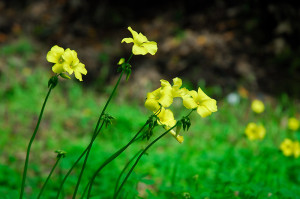
This Oxalis pes-caprae is growing where the infested plants were held prior to transplanting elsewhere
Control
So now what do we do? Reportedly the best control for Oxalis pes-caprae is prevention. “Don’t move soil from an infested site to one that is free of the weed“. Well, for us that’s clearly too late, it’s here, and it’s spreading. We now need to stop it before it spreads further, and escapes into our surrounding woodland.
We don’t use herbicides here, and hand weeding has only limited effectiveness, as removing the top of the plant doesn’t kill the bulbs.
We’re fortunate thus far in that the infestation of this plant is in a relatively small area, in a strip approximately 10 feet long x 4 feet wide. Repeated pulling of the plants, preferably before bloom, helps to deplete the bulb’s nutritional reserves, but this method is time consuming, and can take years to be completely effective. I pulled the Oxalis last spring, but the area of infestation has actually increased this year, so I likely pulled the plants too late, after they had set new bulblets. We now need to redouble our efforts if we’re to be effective at eradicating this species from the property.
Additional control can apparently be obtained by sifting the soil to remove bulblets, unfortunately, where this particular patch is growing, the soil is very shale-like, which will make sifting challenging. An additional method that may in fact be more beneficial here, is soil solarization with transparent or clear plastic [4]. The area this plant has colonized is fallow, so after hand-pulling all visible plants this weekend, our next step will be to attempt to solarize the soil, hopefully limiting regrowth next spring.
If Oxalis once again rears is pretty yellow head next spring, we’ll repeat the process of hand-pulling, followed by solarizing, and later replanting with some native plant species. We’re crossing our fingers that this method will prove successful, but recognize it may take a few growing seasons to bring this invader under control. We’ll let you know how it goes.
——————
[1] California Invasive Plant Council – Oxalis pes-caprae
[2] Nature Conservancy Global Invasive Species Team Weed Alert – Oxalis pes-caprae
[3] Ornduff, R. 1987. Reproductive systems and chromosome races of Oxalis pes-caprae L. and their bearing on the genesis of a noxious weed. Annals of the Missouri Botanical Garden 74: 79-84
[4] UC-IPM – Soil Solarization for Gardens & Landscapes

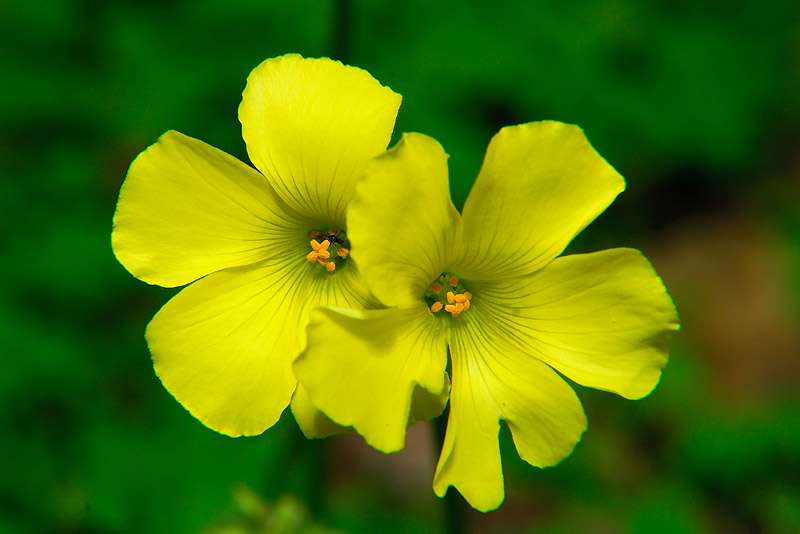

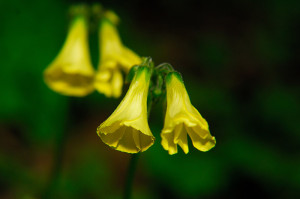
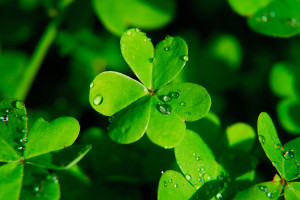
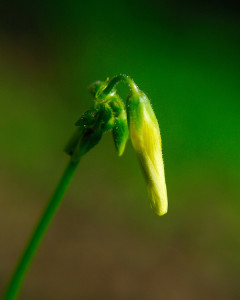

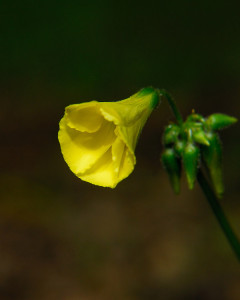

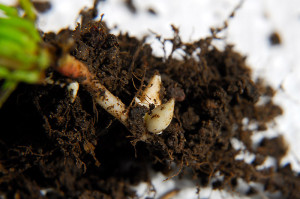

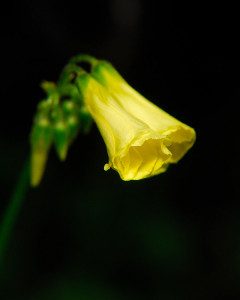
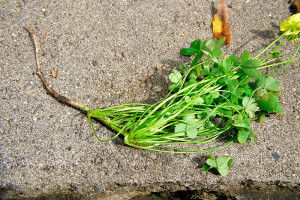

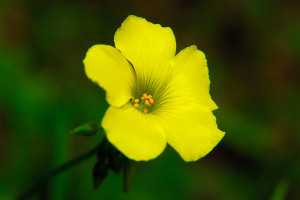







Why is it that the plants we do not want to cultivate are the ones that can survive marginal conditions? I guess we are only seeing and dealing with the ones that survived this far.
I didn’t know that Oxalate pes-caprae is poisonous to livestock. We all have heard that oxalic acid is also found in spinach and it inhibits the absorption of calcium and iron into the human body. That is why I cook my spinach! 🙂
I like the way you captured the bell-shaped appearance of the flowers.
Best of luck eradicating it! We have tons of Oxalis all over. Unfortunately, it was out of control before we bought the property.
I’m sorry Jackie, I don’t envy you. I found a new plant this morning behind the Turkey Pen…quite a distance from this swath…it’s getting away from us! Probably courtesy of the gophers. I expect this may be a bit of an uphill battle.
I hope you can get rid of it. It would be a real pain if it spread beyond that bed, hopefully your organic methods work. I seem to get lots of free weeds with my plants, even the ones from the good nurseries. I learned what the oxalis in my yard is that drives me crazy. It’s the Oxalis conrniculata. I’m pretty sure it came in some mulch we had delivered years ago and it’s now made it’s way to our backyard too.
We have Oxalis corniculata too, but it seems tame compared to pes-caprae. I think our dry summers probably help to keep it in check. It’s also not as big as this plant, so maybe I just don’t notice it as easily 😉
What a shame. I saw a lot of this plant when I lived on the west coast (Vancouver, Canada) but I guess farther north it’s a little less invasive. It was mainly known as a pest there but then I guess that’s how it starts. You don’t think it’s so bad until it gets out of control.
That’s how it started here. A couple of plants, we pulled them, blinked, and before we knew it…it exploded!
I did know that oxalis is a potential hazard to grazing livestock, but did not know that spinach inhibits the absorption of calcium and iron in the human body, as Helen mentioned. I love spinach and was always was under the impression that it was high in iron.
It does! Oxalates, like those found in spinach and rhubarb, bind minerals, like calcium, limiting absorption. It’s my understanding that the high iron content in spinach, not the oxalates per se, that is responsible for reducing iron uptake…but I’m not a nutritionist, nor do I play one on TV 😛
Good for You Clare! It is a pretty little plant but my goodness how it spreads. I have seen it in friends gardens. I do not have any here . . . Bishops weed reigns. If I had to have one invasive . . . I should rather have yours! Mine is impossible to be rid of. Good advice about not moving soil around.
I hadn’t realized when this plant first popped up about it’s proclivity for forming tiny bulbs. I never would have even thought not to plant my plants, or worried about moving soil. I’m (slightly) wiser now. I’ll trade you our Oxalis for Bishop’s weed, and raise you French Broom! 😛
Oh, how frustrating! I do hope you’ll manage to get on top of it, though it does seem challenging indeed.
I’m starting to wonder if we should just spring for the goats now! They’d help keep it under control 😉
I was just reading up on invasive plants for the Midwest; hoping to not contribute to the problem. Then I see what you are up against and I’m a bit freaked out, Clare!
Shyrlene, with the few nasty invasive species we have here, three things seem to be important. The first, you have to understand how the plants propagate. From seed? Bulbs? Root runners? That affects how you manage them. The second, and perhaps most important, is persistence and tenacity when it comes to eradicating them. Even with that, you may have to resort to the third item, which is to accept that you’ll never be rid of the evil invader, but you can at least keep it (somewhat) under control. I don’t like number three, but some of our invasives are easily returned to the property via the birds 🙁
We have a very similar plant called lesser celandine, Ranunculus ficaria, that has invaded the whole bottom of our property. It comes up from the stream so we can’t get rid of it. I hold it to a line, which it is not allowed to cross. But recently it has invaded the neighbor’s yard on the hill above us and is coming down that way too. Sometimes I just want to give up.
It is tempting sometimes to just throw your hands up in defeat, but I’m determined to try and correct this wrong, quickly, as I feel responsible for it being here in the first place 🙁
Entombed? Ouch! I think, our Oxalis doesn’t have to fuss too much with seeds. Just sent its roots down into the ground below that pot, and we are a for away, or b for bulbil?! For me it is only ever a problem if it comes up in a pot, where I was actually trying to grow other bulbs. Moraea for instance. Hate to ask, but will solarization have an effect on buried bulbils?
Entombed does sound like a strong word, but just this weekend I passed a garden with Iris, struggling to grow above the seemingly impenetrable carpet of Oxalis. Quite a sad sight.
I was surprised to read it, but apparently solarization, with clear plastic sheeting, has been shown to be effective with this species. I think the key is probably to solarize early in the season, before the bulbs mature. The ones I unearthed yesterday are very small and tender looking. Let’s hope we can fry them to a crisp 😉
Wow, that is one effective invader! I won’t say how pretty it looks… Good luck trying to get rid of it, at least from your own garden.
It is pretty, in addition to being pretty invasive. I think that’s why a lot of gardeners around here leave it alone. It blooms around the same time as the daffodils here. If it wasn’t such a thug, I wouldn’t mind so much.
Kill kill, destroy destroy. Sorry you’ve been invaded. This plant is so out of control, as you’ve already realized. Unfortunately the best thing to kill it seems to be roundup. I’m not into chemicals either, but sometimes…. But if you really don’t want to use that, digging up around the root and then just sifting/looking through the soil with your hand will help remove alot of the bulblets. Good luck and I hope you win the battle.
This is one of the few times I’ve been sorely tempted to assault a weed with roundup. However, as we have five species of salamanders and Pacific Tree Frogs on the property, I just can’t bring myself to give in. Sifting, pulling, and solarizing will have to work. Otherwise, we’ll have to get goats sooner than we planned 😛
If I could turn a profit from my oxalis and calla lily plantation, I’d be “in clover.”
Seriously, my garden is a demonstration plot for invasive plants.
Awww, you sound like me last year…”if only I had a nickel for every broom plant I’ve ripped out…” Seriously, I probably could have paid for at least one bee hive with that money! 😉
I hear you, Clare. You are not alone! I too fight this noxious weed. (Your photos are stunning!) I too did a post on Oxalis (Triangularis & Regnelli).
They both are such pretty species too Joey. You have to watch out for that Oxalis…the siren of the garden. So beguiling, and easily distracting all who see it from it’s true sinister intent to take over the garden! 😛
Ermm it’s also called ‘English Weed’ though is not a native here either and reached our shores as an ornamental ‘Bermuda buttercup’ in 1757. It’s a pest wherever it goes but I’ve read that grazing by pigs or turkeys, which consume the bulbs, may sometimes be practical! You’ve got the turkeys Clare, so perhaps there will be porkers soon!
Well, pigs can be very damaging to a garden. However, our turkeys may have to start earning their keep 😉 It’s about time our Tom did something other than stand around trying to look impressive all day long!
I’ve heard broom makes a great natural dye. Got any you can spare for my dyepot?
Really? Is it the leaves, flowers, or seed pods that are used for dye? I’m happy to say that other than a few short sprouts, so far we seem to be winning the broom war. My neighbor has some though. If we come up on Sunday I can bring some with me…I’d be happy to get rid of it as it’s by the creek!
I’ll have to check, but I think it’s the whole plant.
Hope to see you Sunday. I think Christine Pyers will be there.
Hello Clare, I know I’m a post behind and have heaps of your news to catch up on, but I wanted to say thanks for such a truly informative post. I am going to have to properly ID the oxalis in my garden…although it is either not as invasive as yours or is out-competed by the couch grass!
good luck with that – you’ll need it. I’ve considered using round-up a few times on the Goutweed (roots) I inadvertently brought home with a Peony division I transplanted in a back field. The field was a quack-grass stronghold until the goutweed started to beat it back. I will go round-up when the goutweed approaches the wood line. Until then I’m taking pleasure at seeing the (racking-fracking) quackgrass get beat up.